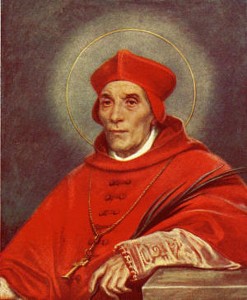
Saint John Fisher (1469-1535) Image: Pinterest
(EWTN) Born in England Yorkshire, John’s early life is practically unknown except for that his early education was likely received in the school annexed to the collegiate Church in his native community–In 1484 he went to Michaelhouse Cambridge to accept a BA degree and proceeded to receive a Masters in 1491 and in that same year, John was elected a Fellow of his college and named Vicar of Yorkshire Northallerton.
In 1494 John resigned his position to become Proctor of his university, three years subsequently he was appointed Master of Michaelhouse about the same time he became a Chaplain and Confessor to Margaret Beaufort, Countess of Richmond & Derby, Mother of King Henry VII — In 1501 John earned a Doctorate of Divinity and was elected Vice Chancellor of Cambridge University. Under John Fisher’s guidance, the Lady Margaret founded ‘St John’s & Christ’s Colleges’ at Cambridge, Dr. John Fisher became the first occupant of the Cambridge Chair.
In 1504 Dr. John Fisher now 35 yrs of age according to Franciscan Media was named Bishop of Rochester and in the same year, was elected Chancellor of Cambridge University (to which post he was reelected annually for ten years) One of Bishop Fisher’s interests was to raising the standard of the ministry in England. Bishop Fisher was an accomplished minister and writer, his Homilies on the Penitential Psalms were even reprinted several times during his lifetime.
Bishop Fisher in 1504 also became the tutor to Prince Henry VIII who later would become King — When King Henry VII and Lady Margaret died, Bishop Fisher was appointed both times to preach at their funeral Masses.
With the coming of Lutheranism, Bishop Fisher was drawn into a controversy, his eight books on heresy gave him a leading position among European theologians.
In 1521 Bishop Fisher was asked to study the question of King Henry VIII who desired an annulment of his marriage, he incurred Henry VIII wrath by defending the validity of it which Pope Clement VII, as I wrote here declared subsequently was valid and indissoluble. — Bishop Fisher also rejected Henry VIII claim to be the supreme head on earth of the Church of England.
In an attempt to get rid of Bishop Fisher, Henry VIII first accused him of not reporting all of the ‘revelations’ of the Nun of Kent. — Now Cardinal Fisher (pursuant to an Order of Pope Paul III believed to induce Henry VIII to treat him less severely) was summoned now in feeble health to take the oath to the new ‘Act of Supremacy’ failure to do so would result execution.
Both Cardinal Fisher and Thomas More (Canonized a Saint by Pope Pius XI) refused because the ‘Act of Supremacy’ presumed the legality of Henry VIII divorce and his claim to be the supreme head on earth of the Church in England.
Cardinal Fisher together with Thomas More (along with his wife and children) were sent to the ‘Tower of London’ where Bishop remained for 14 months without trial.
When Cardinal Fisher and Thomas More were called for interrogation, they both remained silent. Cardinal Fisher was subsequently ‘tricked’ on the belief that he was speaking privately as a Priest–he once more declared that Henry VIII was not the supreme head of the Church of England.
King Henry VIII further angered that Pope Paul III made Fisher a Cardinal, had him brought to trial like Thomas More on Treason — Cardinal Fisher was found guilty, condemned to be hanged, drawn and quartered. The mode of his execution however was subsequently changed and like Thomas More, Cardinal Fisher was beheaded.
Cardinal John Fisher was Beatified in 1886 by Pope Leo XIII and Canonized in 1935 by Pope Pius XI
Tweet